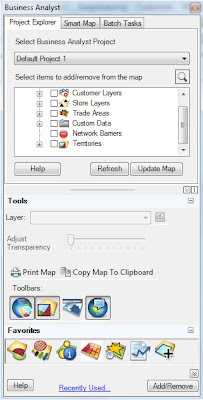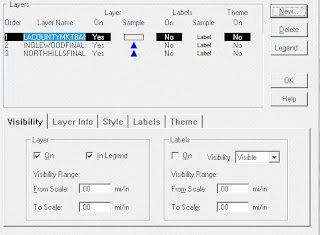Esri Business Analyst 10 Service Pack 1 (SP1) is now available from the Esri Support Center. This service pack contains several performance improvements and maintenance fixes.
Here are some of the issues it is meant to fix that we have heard of... there is an exhaustive list on the Download page.
NIM061242 - BA 10 Bug: Changing the terms "Customer" and/ or "Store" in Preferences does not persist in the wizard's text, i.e. they are still called "Customers" and "Stores" after about the third window during cust/store setup.
NIM061418 - BA 10 Bug: Entering text into the SIC search box, when using Add Business Listings (Classic view), does not work. Work around is to type in caps.
NIM061777 - The word County is duplicated in the label for the County Labels layer . Workaround outlined in kb38382.
NIM061817 - Spatial Query Layers used to create Customer and Store layers crash Business Anlayst 10 (contains workaround).
NIM061901 - When data apportionment is set to Hybrid reports and spatial overlay will return zeroes for rings 10 miles and larger [changing to block apportionment is the workaround].
NIM061902 - BA 10 Bug: After creating/adding a custom bds layer, using the geocoder results in an error: "Geocoding Service is damaged, do you want to repair it?" Restarting BA and not adding the custom bds will resolve the issue.
NIM061969 - BA 10 Bug: Customer Setup to geocode addresses results in Unhandled Exception, referencing out of memory.
NIM061972 - BA 10 Bug: USA Geocoding Service is not Geocoding records it successfully geocoded at 9.3.1.
Let's see if these all got in there, as well as the long list on the Download site, and if you don't see your issue here or there, let us know!
Esri recommends that customers using Business Analyst 10 and Business Analyst Premium 10 download and install this service pack at their earliest convenience. You don't need the core ArcGIS 10 SP1, bit it is also now available from the Esri Support Center, and it should not break anything BA and offers some core improvements and fixes that may be helpful.
Special Interest Group for financial service professionals, dealing with business geography challenges. Focuses on ArcGIS, Business Analyst (BA) & other ESRI software, but open to all.
Tuesday, November 30, 2010
Wednesday, November 17, 2010
Centralized Layer Management
 One of many cool things in Business Analyst 10 is the Project Explorer tab of the Business Analyst Window. For the first time, ArcGIS users can manage layers centrally, instead of having to open them one at a time. This is especially tedious when making changes.
One of many cool things in Business Analyst 10 is the Project Explorer tab of the Business Analyst Window. For the first time, ArcGIS users can manage layers centrally, instead of having to open them one at a time. This is especially tedious when making changes.Now, in one powerful window or dialog, we can choose which Project to work with; which layers are on and off in the project, and the transparency of each layer. There are also helpful project level controls allowing you to print the map, copy it to the clipboard, add or remove toolbars.
Most powerfully, one can perform analysis on the layer by choosing a tool/wizard from the Favorites bar. The defaults include Spatial Overlay, Dynamic Rings, Drive Time, Grid, and Custom Data Setup to prepare one of your own layers for analysis.
Where are we going with this? Back to the future.
Here is the Layers and Themes control in Atlas GIS 4.0, which to date has been the only ESRI product with centralized layer management.
 In Atlas, one has control over most of the important settings for each layer in one convenient place, including visible range, theme, symbology (style), label settings, legend, and layer info (source tab).
In Atlas, one has control over most of the important settings for each layer in one convenient place, including visible range, theme, symbology (style), label settings, legend, and layer info (source tab).Which is among the reasons why, 10 years after it was discontinued, we still get calls for help with Atlas GIS, and we still produce a low cost geocoder for those who can't bear to part with it.
Wednesday, November 10, 2010
Can Brand Perceptions Impact Store Attractiveness?
The answer is, perceptions of customer service and value of the overall brand may absolutely impact store attractiveness - in fact, GIS analysis suggests they can make all the difference.
Here's a little market in Minnesota, but it could be your neighborhood. There are four banking competitors and six branches here in the space of about 1/2 a mile - US Bank with two branches to the north, TCF Bank with two to the southeast, and Wells Fargo and M&I with one branch each towards the west. Using customer perceptions of Overall Satisfaction, Reasonable Fees and Easy to Resolve Problems from the most recent JD Power Retail Banking Study for this region, we assigned the JD Power scores for each bank to each of its branches. Then, we ran a very basic Huff model based on these perceptions, at left.
The analysis shows that M&I will be able to successfully compete in this market with a much smaller office, and just one office, because the perceived service quality and value are attractive enough to have influence throughout the entire southern portion of the area. To the north, US Bank benefits from having two offices with better perceptions than either Wells or TCF, and dominates the entire northern area.
Based on deposits, which with date opened and several other factors is usually considered a key factor of attractiveness, we would expect something entirely different, depicted to the right in a model based purely on deposit size. M&I is overwhelmed in this analysis, by the large Wells branch, the two TCFs including one large office, and the two US Bank locations.
Looking at the same neighborhood by equal competition or Thiessen analysis, where equidistant lines are drawn between each branch and its adjacent branches, this tends to flatter the institutions with multiple branches (left).
Simple rings tend to flatter the multibranch US Bank and TCF even more, as they dominate the market to the north and south, respectively.
Meanwhile, drivetime polygons tend to depict a lot of overlap, given the immediate proximity of all the offices to a single, main intersection.
Hardly definitive, but food for thought. To what extent can perceptions of good customer service and value overcome weaker convenience and ease of access, and how do we model it in GIS? By the way, that is RPM's MarketBank potential for deposits as the underlying theme, the greener the better.
Here's a little market in Minnesota, but it could be your neighborhood. There are four banking competitors and six branches here in the space of about 1/2 a mile - US Bank with two branches to the north, TCF Bank with two to the southeast, and Wells Fargo and M&I with one branch each towards the west. Using customer perceptions of Overall Satisfaction, Reasonable Fees and Easy to Resolve Problems from the most recent JD Power Retail Banking Study for this region, we assigned the JD Power scores for each bank to each of its branches. Then, we ran a very basic Huff model based on these perceptions, at left.
The analysis shows that M&I will be able to successfully compete in this market with a much smaller office, and just one office, because the perceived service quality and value are attractive enough to have influence throughout the entire southern portion of the area. To the north, US Bank benefits from having two offices with better perceptions than either Wells or TCF, and dominates the entire northern area.
Based on deposits, which with date opened and several other factors is usually considered a key factor of attractiveness, we would expect something entirely different, depicted to the right in a model based purely on deposit size. M&I is overwhelmed in this analysis, by the large Wells branch, the two TCFs including one large office, and the two US Bank locations.
Looking at the same neighborhood by equal competition or Thiessen analysis, where equidistant lines are drawn between each branch and its adjacent branches, this tends to flatter the institutions with multiple branches (left).
Simple rings tend to flatter the multibranch US Bank and TCF even more, as they dominate the market to the north and south, respectively.
Meanwhile, drivetime polygons tend to depict a lot of overlap, given the immediate proximity of all the offices to a single, main intersection.
Hardly definitive, but food for thought. To what extent can perceptions of good customer service and value overcome weaker convenience and ease of access, and how do we model it in GIS? By the way, that is RPM's MarketBank potential for deposits as the underlying theme, the greener the better.
Monday, November 1, 2010
Blind To Site, Part III
Back in the day... Site work used to be so much... work.
Trudging around, filling out a site questionnaire longhand that would only need to be transferred to a computer later.
 Then, brought step by step into a spreadsheet, a database.
Then, brought step by step into a spreadsheet, a database.Then finally into desktop GIS, ultimately to be integrated with the existing network.
Fumbling for a camera to take photos. Mumbling voice notes into a hand-held voice recorder. Scrambling on the cellphone to relay results. Worst of all, dropping the notebook PC you brought out with you, ostensibly to save a little time.
No more. Now we do it all on the Samsung Ultra Mobile PC. On one tablet device, I can do it all - photos, voice, full Excel spreadsheet, even ArcGIS.
Suddenly, what used to take forever and was no fun at all is now made quick, easy, fast. Work has become a pleasure again. I can collect all the rich data I need in every way I need literally in the palm of my hand.
And integrate my field work with the network in real time.
Not to mention that tablet computing is a blast, and definitely the next Big Thing (witness the IPad).
However - unlike the IPad, this Samsung has an integrated QWERTY keyboard - and more importantly, a full blown OS (Windows XP SP3), a powerful mobile CPU, and fully 2GB of RAM. And if you are not quite as literate texting as your kids are, you can write longhand right onto the PC using a stylus and an input area, and the handwriting recognition kicks in.
What a joy it is to gather the info digitally, once,
into an Excel spreadsheet...
then pull that into ArcGIS...
integrate it with the existing network...
analyze the impact on that network...
compare it with other site options... and
distribute the information throughout the organization and to partners before I even get back into the car to drive to the next site.

We've been using these Samsung UMPCs for over three years now, and we love them. More so, we're in love with tablet computing.
So much so, we just bought one of Samsung's new 40 inch touchscreens.
Now, I just have to find a way to mount it into my vehicle.
Subscribe to:
Posts (Atom)







